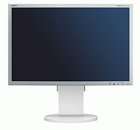Thursday, September 10th 2009

NEC Preps White LED Backlit MultiSync Monitor
NEC Display Solutions is readying its first MultiSync LCD monitor that uses a white LED backlit for illumination. The Multisync EA222WMe is a 22 inch panel that brandishes the company's green initiatives, and with its white LED illumination, reduces energy consumption by up to 50% against traditional CCFL-illuminated LCD displays. It manages a brightness of 250 cd/m², and has a One Touch Eco Button power management feature that further reduces power consumption. Connectivity options include DVI and DisplayPort. The Multisync EA222WMe is targeted at the SMB segment. It will reach retailers by this December.
Source:
PRAD

22 Comments on NEC Preps White LED Backlit MultiSync Monitor
Is that really asking too much?
That said, res and refresh rate would be nice specs to have. Hell, even price would be handy... No point harping on all this "eco-friendly" business when you can't run the numbers to see if the premium you'll undoubtably pay will actually make up for itself in a reasonable period of time.
Samsung have been making LED backlit screens for some time now, mines one of em.
45W max power on a 24", vs the 150W my old 19" CRT used to use - its awesome.
LED's use a lot less power for the same illumination. CCFL (cold cathode fluorescent light)s use a lot of power.
and lol, yeah you really dont know much about LCD's - pretty much the ENTIRE power consumption comes from the backlight. the rest is minimal.
However, there is still an issue behind LEDs for backlighting, which is their production of the color white. There are two ways LEDs produce white light, a blue phosphor coating that emits what looks like white light to our eyes, and then combining red/green/blue LEDs. The latter is the best option, but is more costly and takes up more space, yet still isn't a perfect reproduction of white light. I'm sure at some point this will be overcome as well, but in the meantime, i would think it would effect picture quality. The other issue with color rendering is heat, LEDs are very sensitive to heat and they change their color frequency depending on how hot they are. This can also be a problem because of their thermal runway. If they get to hot, they will go into self destruct mode. Increasing heat will increase resistance and heat will continue to rise and the LEDs will burn out. This is why you see those huge heat sinks on commercial LED lights, cooling is very important. The downside to that is you have to add the cost of whatever heatsink material to the monitor.
As far as gains go, you would still have to stuff a lot of LEDs in the area to cover enough ground to light the whole screen vs a tube. Anyways, i can see about 5-10w in power reduction, and that is it, especially in something this small. This figuring they are using class II 1w emitters.
and yes, it is entirely true that the LCD itself uses very little power.
CCFL's use less power than a hot cathode - and LED's use about half again what cold cathodes use.
how about this: i provide evidence and proof, and you counter with your own evidence - not merely things you've 'decided' are truth.
Older, 24" LCD screen - CCFL backlight.
www.vdhsoft.be/sp32/32058.htmModern LED backlit 24"
www.eyo.com.au/prod_H-2494HS_proddesc_SAMSUNG_2494HS_LCD_23.6_W_BLACK_5MS_HDMI_SPK_LS24KIVKBQ_XSA.html85W to 48W is a 44% decrease - so, uhh... 50% claims really arent BS?
get offended all you want, if you're the kind that cant take being proven wrong - but rest assured that i do my very best to make sure people dont spread false information around here and mislead people. (and i do get proven wrong on occasion, and admit it - but this is not one of those cases)